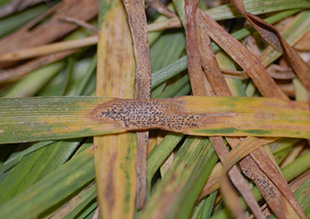G1671
Management of Residue-Borne Diseases of Winter Wheat
Recommendations for an integrated management plan to reduce the development of residue-borne diseases in no-till and reduced tillage systems.
Stephen N. Wegulo, Extension Plant Pathologist
Robert N. Klein, Extension Western Nebraska Crops Specialist
- Crop Rotation
- Resistant, Locally Adapted Cultivars
- Planting Date
- Stand Establishment
- Weed Control
- Fungicides
- Crop Residue Management
Due to the need to prevent soil erosion and conserve soil moisture in Nebraska, emphasis has been placed on conservation tillage, a practice that leaves crop residues on the soil surface after harvest. Crop residues provide food and act as a habitat for certain plant pathogens of wheat (Table I). Residue-borne wheat diseases that occur in Nebraska include tan spot (Figures 1 and 2), Septoria leaf blotch (Figure 3), Septoria leaf and glume blotch, take-all (Figures 4 and 5), Cephalosporium stripe (Figure 6), and root and crown rots and associated seedling blights caused by Fusarium spp. and Bipolaris spp. (Figure 7).
| Table I. Residue-borne diseases of wheat and strategies to manage them. | ||
| Disease | Pathogen(s) | Management |
| Tan spot | Pyrenophora tritici-repentis | Crop rotation; resistant cultivars; foliar fungicides; seed treatment fungicides |
| Septoria leaf blotch | Septoria tritici | Crop rotation; resistant cultivars; foliar fungicides |
| Septoria leaf and glume blotch | Stagonospora nodorum | Crop rotation; resistant cultivars; foliar fungicides; seed treatment fungicides |
| Cephalosporium stripe | Cephalosporium gramineum | Plant at recommended date; crop rotation; resistant cultivars |
| Eyespot (foot rot, strawbreaker) | Pseudocercosporella herpotrichoides | Crop rotation; resistant cultivars; foliar fungicides |
| Sharp eyespot | Rhizoctonia cerealis | Crop rotation; resistant cultivars; avoid planting too early |
| Common root rot; seedling blight; spot blotch | Cochliobolus sativus | Plant clean, pathogen-free seed; crop rotation; resistant cultivars; plant at recommended date; plant into firm, mellow seedbed; control weeds; seed treatment fungicides; foliar fungicides |
| Fusarium seedling blight; foot rot; dryland foot rot | Fusarium graminearum; F. culmorum | Plant clean, pathogen-free seed; crop rotation; resistant cultivars; plant at recommended date; plant into firm, mellow seedbed; control weeds; seed treatment fungicides; foliar fungicides |
| Fusarium head blight (scab) | Fusarium graminearum | Crop rotation; resistant cultivars; seed treatment fungicides; foliar fungicides at heading |
| Take-all | Gaeumannomyces graminis var. graminis; G. graminis var. tritici | Crop rotation; control grass weeds and volunteer cereals; plant seed into firm, well-drained soil; balanced fertilizer program |
| Pink snow mold | Microdochium nivale | Crop rotation; resistant cultivars; weed control; plant at recommended date; seed treatment fungicides; foliar fungicides before snowfall |
| Speckled snow mold | Typhula idahoensis | Crop rotation; resistant cultivars; weed control; plant at recommended date; seed treatment fungicides; foliar fungicides before snowfall |
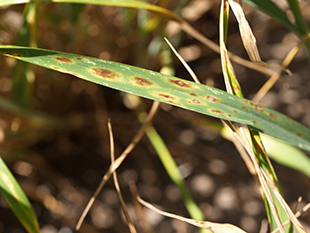 |
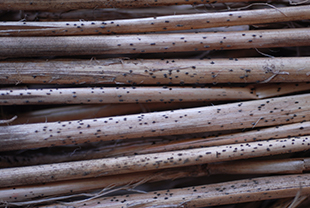 |
|||
| Figure 1. Tan spot lesions on a wheat leaf. | Figure 2. Pseudothecia (fruiting and overwintering structures) of the tan spot fungus on wheat residue. | |||
|
||||
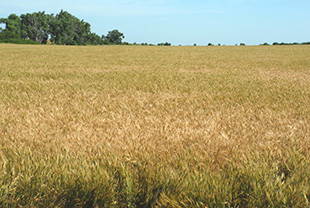 |
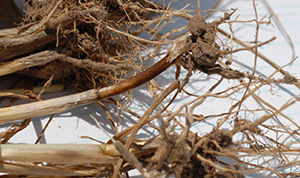 |
|||
| Figure 4. A take-all patch in a wheat field. | Figure 5. Blackening of the basal stem is a diagnostic symptom of take-all. | |||
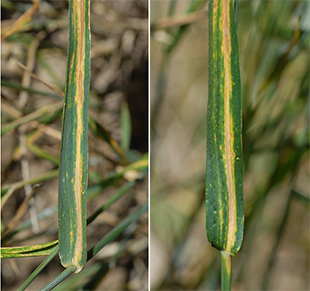 |
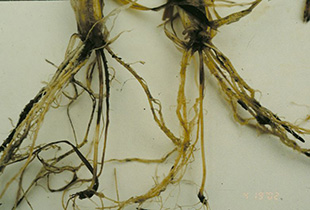 |
|||
| Figure 6. Cephalosporium stripe on wheat. Left, upper leaf surface; right, lower leaf surface. | Figure 7. Root and crown rot caused by Fusarium spp. and Bipolaris sorokiniana. (Photo credit: Robert M. Harveson.) | |||
This NebGuide discusses management strategies for residue-borne diseases of wheat. The best approach is to combine available strategies into an integrated disease management program. Proper residue management can result in healthier, vigorous plants that are able to resist pathogen attack, especially during the early stages of growth. Therefore, a discussion on crop residue management is included.
Crop Rotation
Crop rotation is one of the most effective cultural practices used to manage residue-borne diseases. Rotation to non-host crops allows time for pathogen-infested residues to degrade in the absence of new host tissue. As the residues decompose, food supply to the pathogen is depleted. This results in death of pathogen propagules (mycelia, spores, and fruiting and resting structures). When wheat is planted following a non-host crop, disease intensity will be lower due to reduced pathogen populations. If wheat is planted after wheat, pathogen populations will generally be greater and result in higher disease intensity and greater yield loss. Disease intensity will likely increase each season in continuous wheat cropping systems.
Resistant, Locally Adapted Cultivars
Wheat cultivars with varying levels of resistance or tolerance to some residue-borne diseases are available (see the University of Nebraska–Lincoln Fall Seed Guide: http://ianrpubs.unl.edu/epublic/live/ec103/build/ec103.pdf; other resources on cultivar resistance are available at: http://cropwatch.unl.edu/web/wheat/variety). Resistance, when available, is the most effective and least expensive means of managing plant diseases. Planting resistant or tolerant cultivars reduces or eliminates the costs associated with buying and applying fungicides. Hence, increased profit margins can be realized.
The cultivars selected based on disease resistance or tolerance also should be adapted to the local environment. This is important because locally adapted cultivars are less prone to environmental stresses which predispose them to disease.
Planting Date
Planting date can have a significant effect on the severity of some residue-borne diseases. Cephalosporium stripe, for example, will be more severe if wheat is planted too early because the excessive root growth provides more entry points for the pathogen when roots are subjected to winter injury. Similarly, severity of common root rot, seedling blight, and spot blotch caused by Bipolaris spp. and Fusarium spp. will be greater if wheat is planted too early because infection and disease development are favored by warm temperatures. The best planting date is the one recommended for the local area or geographical region. For example, at North Platte, Neb., wheat planted Sept. 2 yielded 2 bu/acre, wheat planted Sept. 15 yielded 27 bu/acre, and wheat planted Sept. 25 yielded 42 bu/acre. Sept. 25 is close to the recommended planting date.
Stand Establishment
For good stand establishment, wheat should be planted in a firm, moist, and mellow soil. Healthy, vigorous seedlings can resist pathogen attack better than weak seedlings. Planting depth should be 1 to 1½ inches in medium to fine textured soils and 2 inches in coarse textured soils. Soil condition should allow good soil to seed contact.
Weed Control
Some residue-borne pathogens of wheat infect certain grassy weeds. Controlling weeds and volunteer cereals can help reduce pathogen inoculum and, consequently, disease intensity during the growing season. Details on weed control are covered in the section Crop Residue Management.
Fungicides
A variety of fungicides can control residue-borne wheat diseases. Foliar fungicides (Table II) control diseases such as tan spot, Septoria tritici blotch, and eyespot. Residue-borne pathogens causing root and crown rots, seedling blights, and seed-transmitted foliar diseases can be managed by applying fungicide seed treatments (Table III).
| Table II. Fungicides registered for use on wheat to control foliar diseases1. | |||||
| Fungicide trade name2 | Active ingredient | Fungicide class | Rate (per acre) | Re-entry interval (REI) (hours) |
Pre-harvest interval (PHI) (days) |
| Absolute | tebuconazole + trifloxystrobin | triazole + strobilurin | 5.0 fl oz | 24 | 35 |
| Alto | cyproconazole | triazole | 3.0-5.5 fl oz | 12 | 30 |
| Bumper | propiconazole | triazole | 4.0 fl oz | 24 | 40 |
| Caramba | metconazole | triazole | 10.0-14.0 fl oz | 12 | 30 |
| Evito | fluoxastrobin | strobilurin | 2.0-4.0 fl oz | 12 | Apply no later than Feekes 10.5 (full heading) |
| Folicur | tebuconazole | triazole | 4.0 fl oz | 12 | 30 |
| Headline | pyraclostrobin | strobilurin | 6.0 fl oz | 12 | Apply no later than Feekes 10.5 |
| ManKocide | Mancozeb + copper hydroxide | Dithiocarbamate + inorganic | 1.7 lb | 48 | Apply no later than Feekes 10.5 |
| Muscle | tebuconazole | triazole | 4.0 fl oz | 12 | 30 |
| Orius | tebuconazole | triazole | 4.0 fl oz | 12 | 30 |
| Priaxor | fluxapyroxad + pyraclostrobin | carboxamide + strobilurin | 8.0 fl oz | 12 | Apply no later than Feekes 10.5 |
| Proline | prothioconazole | triazole | 4.3-5.7 fl oz | 12 | 30 |
| PropiMax | propiconazole | triazole | 2.0-4.0 fl oz | 24 | 40 |
| Prosaro | prothioconazole + tebuconazole | triazole + triazole | 6.5-8.2 fl oz | 12 | 30 |
| Quadris | azoxystrobin | strobilurin | 6.0-15.5 fl oz | 4 | Apply no later than Feekes 10.5 |
| Quilt | propiconazole + azoxystrobin | triazole + strobilurin | 10.5-14.0 fl oz | 12 | Apply no later than Feekes 10.5 |
| Quilt Xcel | azoxystrobin + propiconazole | strobilurin + triazole | 10.5-14.0 fl oz | 12 | Apply no later than Feekes 10.5 |
| Stratego | propiconazole + trifloxystrobin | triazole + strobilurin | 10.0 fl oz | 12 | Apply no later than Feekes 10.5 |
| Stratego YLD | prothioconazole + trifloxystrobin | triazole + strobilurin | 4.0 fl oz | 12 | Apply no later than Feekes 10.5 |
| Tebuzol | tebuconazole | triazole | 4.0 fl oz | 12 | 30 |
| Tilt | propiconazole | triazole | 2.0-4.0 fl oz | 12 | 30 |
| Toledo | tebuconazole | triazole | 4.0 fl oz | 12 | 30 |
| TwinLine | pyraclostrobin + metconazole | strobilurin + triazole | 7.0-9.0 fl oz | 12 | Apply no later than Feekes 10.5 |
| Vertisan | penthiopyrad | carboxamide | 10.0-24.0 fl oz | 12 | Apply no later than Feekes 10.5.1 (flowering) |
| 1This list is presented for information only and no endorsement is intended for products listed or criticism meant for products not listed. Consult the product label before buying and using a specific fungicide. Read and follow all label directions and restrictions. 2The label on most of the products listed in Table I recommends adding an appropriate adjuvant such as a spreader sticker and applying in sufficient water to ensure good coverage. Higher carrier rates usually improve control. It is very important to select application equipment which gives the spray particle size suggested on the label. |
|||||
| Table III. Representative seed treatment fungicides registered for control of residue-borne, soilborne, and seed-borne diseases of wheat1. | |||
| Fungicide | Active Ingredient | Fungicide Class | Rate (per 100 lb) |
| Acquire | metalaxyl | acylalanine | 0.75 fl oz |
| Apron XL LS | mefenoxam | acylalanine | 0.32-0.64 fl oz |
| Captan 400 | captan | phthalimide | 1.5-4.0 fl oz |
| Charter F2 | triticonazole + metalaxyl | triazole + acylalanine | 5.4 fl oz |
| CruiserMaxx Cereals | difenoconazole + mefenoxam + thiamethoxam | triazole + acylalanine + neonicotinoid | 5.0 fl oz |
| CruiserMaxx Vibrance Cereals | sedaxane + difenoconazole + mefenoxam + thiamethoxam | carboxamide + triazole + acylalanine + neonicotinoid | 5.0-10.0 fl oz |
| Dithane M45 | mancozeb | dithiocarbamate | 2.2-3.3 fl oz |
| Dividend Extreme | difenoconazole + mefenoxam | triazole + acylalanine | 1.5-2.0 fl oz |
| Dynasty | azoxystrobin | strobilurin | 0.153-0.382 fl oz |
| Enhance AW | captan + carboxin + imidacloprid | phthalimide + carboxamide + neonicotinoid | 4.0 oz |
| Incentive RTA | difeconazole + mefenoxam | triazole + acylalanine | 2.5-10.0 fl oz |
| Mankocide | mancozeb + copper | hydroxide dithiocarbamate + inorganic | 4.0 fl oz |
| Maxim XL | fludioxonil + mefenoxam | phenylpyrrole + acylalanine | 0.167-0.334 fl oz |
| Maxim 4FS | fludioxonil | phenylpyrrole | 0.08-0.16 fl oz |
| NipsIt Suite Cereals | metconazole + metalaxyl + clothianidin | Triazole + acylalanine + neonicotinoid | 5.0-7.5 fl oz |
| Prevail | carboxin + PCNB + metaxyl | carboxamide + aromatic hydrocarbon + acylalanine | 1.5-3.0 fl oz |
| Proceed | prothioconazole + tebuconazole + metalaxyl | triazole + triazole + acylalanine | 5.0-7.5 fl oz |
| Rancona 3.8 FS | ipconazole | triazole | 0.051-0.085 fl oz |
| Rancona Crest | ipconazole + metalaxyl + imidacloprid | triazole + acylalanine + neonicotinoid | 5.0-8.33 fl oz |
| Rancona Pinnacle | ipconazole + metalaxyl | triazole + acylalanine | 5.0-8.33 fl oz |
| Raxil 2.6F | tebuconazole | triazole | 0.1 fl oz |
| Raxil MD | tebuconazole + metalaxyl | triazole + acylalanine | 5.0-6.5 fl oz |
| Raxil MD Extra | tebuconazole + metalaxyl + imazalil | triazole + acylalanine + azole | 5.0 fl oz |
| Raxil MD Extra W | tebuconazole + metalaxyl + imazalil + imidacloprid | triazole + acylalanine + azole + neonicotinoid | 3.5-4.6 fl oz |
| Raxil MD W | tebuconazole + metalaxyl + imidacloprid | triazole + acylalanine + neonicotinoid | 5.0 fl oz |
| Raxil-Thiram | tebuconazole + metalaxyl + imidacloprid | triazole + acylalanine + neonicotinoid | 5.0 fl oz |
| Raxil XT | tebuconazole + metalaxyl | triazole + acylalanine | 0.16-0.20 oz |
| RTU-Vitavax-Thiram | carboxin + thiram | carboxamide + dithiocarbamate | 5.0-6.8 fl oz |
| Stamina | pyraclostrobin | strobilurin | 0.4-0.8 fl oz |
| Stamina F3 Cereals | pyraclostrobin + triticonazole + metalaxyl | pyraclostrobin + triticonazole + metalaxyl | 4.6 fl oz |
| Stamina F3 HL | pyraclostrobin + triticonazole + metalaxyl | strobilurin + triazole + acylalanine | 1.0 fl oz |
| Vibrance | sedaxane | carboxamide | 0.08-0.16 fl oz |
| Vibrance Extreme | sedaxane + difenoconazole + mefenoxam | carboxamide + triazole + acylalanine | 2.8-5.6 fl oz |
| Vitavax-34 | carboxin | carboxamide 2.0-3.0 oz | |
| 1This list is presented for information only and no endorsement is intended for products listed or criticism meant for products not listed. Consult the product label before buying and using a specific fungicide. Read and follow all label directions and restrictions. | |||
Crop Residue Management
To reduce soil erosion from wind and water, crop residue needs to be maintained on the surface. The approximate amounts of crop residue for conservation compliance are listed in Table IV. Check with your local USDA-Natural Resources Conservation Service office for the requirements for your fields.
Table IV shows the importance of maintaining residue on sandy soils and soils with slopes greater than 5 or 9 percent. Greatest susceptibility to wind erosion in Nebraska occurs during the high wind months of March, April, and May. Water erosion is also important during these months because of the potential for high precipitation. Maintaining crop residue when soil is most susceptible to erosion is important and should be part of the overall residue management program. Good fallow practices, along with good stands of adapted winter wheat varieties planted and fertilized according to recommended practices, plus effective weed control in the growing crop, usually result in a large amount of quality residue. It is very important to spread the straw and chaff at harvest to aid in the residue management program.
| Table IV. Typical crop residue required for conservation compliance in a winter wheat-fallow rotation. | ||
Erosion Type |
||
Water |
Wind |
|
| Soils that require residue | 5% or greater slope 9% or greater slope in Panhandle |
Fine sand Loamy fine sand Fine sandy loam |
| % Residue cover required March, April, May | 50% |
45% |
| % Residue cover required from June through after planting | 30% |
15% |
To control weeds in crop residue during the fallow period consider using herbicides. Appropriate control tactics depend on the weed populations present in the field. If there are few weeds at harvest, it may be advisable to delay herbicide application until late August and then use glyphosate or Gramoxone Inteon plus atrazine and, in many situations, 2,4-D and/or dicamba will need to be added if glyphosate is used because many weeds are resistant to glyphosate. Adding 2,4-D and/or dicamba increases problems with spray drift. The atrazine rate depends on soil type, pH, organic matter and the succeeding crops. The next herbicide application or tillage operation can then be delayed until late May or early June, if the field is fallowed the next summer.
If there are heavy populations of annual grass weeds at harvest, apply glyphosate or use a sweep tillage operation soon after harvest. If broadleaf weeds are present, add 2,4-D and/or dicamba (see comments in the previous paragraph on adding these products). This has at least two positive effects. Controlling the annual grass weeds prevents them from using moisture and producing seed. In addition, many of the annual grass weeds are hosts of the wheat curl mite which can transmit wheat streak mosaic virus and Triticum mosaic virus. Removing the weeds reduces the risk of transmitting the viruses to the fall sown wheat crop. A second application of atrazine plus glyphosate or Gramaxone Inteon or tillage should be made in August or early September if necessary. This should control most weeds until the following spring.
By using herbicides to control weeds in the fall after wheat harvest, you can delay tillage until late May or early June and use tillage implements that maintain crop residue. Sweeps, chisel plows and rodweeders are effective at killing weeds, but should not be used in cool moist weather, which is typically early in the season.
If the field is going to be fallowed and planted to winter wheat in the coming fall, use either herbicides or tillage to control weeds in the spring. Some producers use one application of glyphosate with or without 2,4-D and/or dicamba (see previous note on adding these products), depending on the weeds present, and then use tillage to control weeds and prepare a seedbed. This is a good option for those without no-till drills. For those with no-till drills, weed control during the entire prewheat fallow period (spring to wheat seeding in the fall) may be achieved with herbicides such as glyphosate, 2,4-D, or dicamba, depending on weeds present. Always observe the rotation restrictions and days required before seeding following herbicide applications, as advised on herbicide labels. In the early stages of no-till, penetration by a no-till drill may be a problem, especially if the late summer and early fall are dry and hot. In subsequent years, penetration by the drill is easier in the more mellow soils.
If a spring seeded crop is to be grown, maintaining the crop residue is also very important for weed control and water conservation. The success of the spring crop is often directly correlated to the efficiency of weed control after winter wheat harvest. Good weed control results in increased soil moisture and reduced weed seed production. Also, effective and timely annual grass weed control (including volunteer wheat) is important in the winter wheat disease management program. Well maintained crop residue acts as mulch and reduces the number of weeds that emerge.
There are many benefits from maintaining crop residue in addition to soil conservation. These include higher moisture retention by trapping snow, slowing water movement, increasing water infiltration, lowering soil temperature, and improving habitat for wildlife. Because of these benefits, it is desirable to manage residue-borne diseases through methods that do not destroy crop residue.
This publication has been peer reviewed.
Disclaimer Reference to commercial products or trade names is made with the understanding that no discrimination is intended of those not mentioned and no endorsement by University of Nebraska–Lincoln Extension is implied for those mentioned. |
Visit the University of Nebraska–Lincoln Extension Publications website for more publications.
Index: Plant Diseases
Wheat
2006, Revised January 2013
